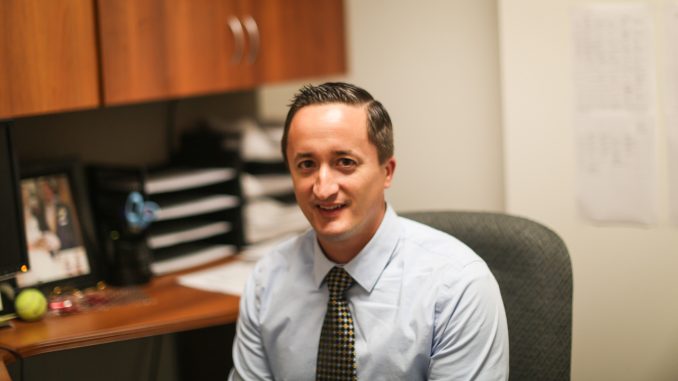
As a baseball player through high school, Stephen Thomas was inspired to study athletic training and sports medicine once he got to college.
“It was easier for me to understand the anatomy and how it works and the mechanics,” said Thomas, a kinesiology professor. “Not to mention being a fan of baseball and seeing young athletes get an injury that literally ends their career. And they had huge potential.”
In 2014, Thomas created the Adaptations to Repetitive Motion and Stress research laboratory, which studies athletes who play sports that involve overhead motion, like baseball and swimming, and tries to prevent overuse injuries related to those sports. The research emphasizes athletes’ shoulders.
“I got drawn to the shoulder because of baseball,” said Thomas, who is also a 2006 athletic training master’s alumnus. “It was easier for me to understand the anatomy and the mechanics.”
The lab focuses on athletes who constantly repeat the same muscle movements during a season, which causes a lot of stress on their bodies. The researchers’ ultimate goal is determining how to achieve optimal recovery, Thomas said.
The ARMS lab at Temple is part of the Penn Throwing Clinic, a service that helps athletes prevent injuries and enhance their performances.
Undergraduate and graduate students join doctors from all over Philadelphia and New York to work in the lab. John Kelly, a clinical orthopedic surgery professor at the University of Pennsylvania, works as the lab’s director.
Kelly has about 30 years of practice studying shoulder and sports injuries and said he’s enthusiastic about the lab. In 2000, Kelly worked in the Department of Orthopedics and Sports Medicine, where he met Thomas.
“I love Stephen Thomas and all of the work that we have done,” Kelly said. “The research that we are currently doing is groundbreaking.”
“We optimize their performance and recognize what factors will put the throwers at high risks,” Kelly said. “By looking at certain powers, we can associate them with risks of higher injuries. Our job is to identify these patterns and correct them as soon as possible.”
The lab’s extensive study is opening doors in the medical field, Thomas said, through new discoveries like deeming some current injury treatment methods ineffective. The ARMS lab takes a deeper look into the athletes’ movements, figuring out exactly how they affect athletes and then figuring out injury solutions that work.
“With baseball players, we have been able to identify that they lose certain motions and internal rotations as they throw,” Kelly said.
While the lab works with active athletes, it doesn’t research Temple’s student-athletes because the university no longer has a Division I baseball team. Instead, players from other universities like Penn participate.
Some minor-league players come to the clinic as well, and major-league players play a crucial role in Thomas’s study. Through his lab work, Thomas has a personal affiliation with the Philadelphia Phillies and regularly attends spring training with the team.
He said the ARMS lab collects data on professional pitchers because they are the best player population to target and a good starting point for his research.
“You can always trickle back to the youth, high school or college,” Thomas added. “But if we are going to see differences, it is going to be in these professional athletes because their volume and tendency is higher than anyone else.”
Thomas’ research constantly evolves, and the lab’s workers believe the clinic has a bright future.
Ryan Paul, a junior exercise and sports science major who pitches for Temple’s club baseball team, started working at the lab during his freshman year. He said the research brings a broader understanding to the sports medicine field by analyzing several different aspects like structural adaptation, ligament and tendon studies.
For Thomas, his personal connection to sports makes the work even more meaningful.
“Any way that I can allow athletes to see their full potential and eventually not have that sport come to an end for them is the motivator,” he said. “Having gone down that road, definitely hits home for me.”


Be the first to comment